Famine Algorithm and Pseudo-Kinetic Energy for Structural Damage Detection
Abstract
In this study, a novel damage detection framework for skeletal structures is presented. The introduced scheme is based on the optimization-based model updating method. A new multipopulation framework, namely, the Famine Algorithm, is introduced that hopes to reduce the number of objective function evaluations needed. Furthermore, using static displacement patterns, a damage-sensitive feature named pseudo-kinetic energy is presented. By exploiting the new feature, an efficient cost function is developed. Two mathematical benchmark problems and a two-membered truss for damage detection problem are depicted in 2D space to track the search behavior of the Famine Algorithm and show the changes in the search space when using the new feature. Four numerical examples, including three trusses and a frame structure, are used to evaluate the overall performance of the proposed damage detection methods. Moreover, an experimental shear frame is studied to test the performance of the suggested method in real-life problems. The obtained results of the examples reveal that the proposed method can identify and quantify the damaged elements accurately by only utilizing the first five vibrating modes, even in noise-contaminated conditions.
1. Introduction
The structural health monitoring (SHM) field continues to grow due to its importance for structural safety and preventing catastrophic events, such as the sudden collapse of buildings, bridges, and other significant structures. Because of the inefficiency of dated methods like visual inspection in the early detection of damage, methods based on processing the data measured by sensors were introduced. Due to the reduction of computational costs in recent decades, a more detailed analysis of vibration data is available to detect damage. A detailed explanation of early developments in damage detection can be found in [1, 2]. The dynamic characteristics of a structure are sensitive to changes in its physical properties. When the damage causes a change, it is possible to find its severity and location by solving the inverse dynamic problem. There are several tools to solve this problem.
Recently, novel tools, especially artificial intelligence, including optimization algorithms and machine learning, have become increasingly popular because of their advances. These tools have made significant developments in the field of health monitoring. High-speed Internet and cloud computing have made these tools easier to implement in real-life structures [3]. First-order Eigen perturbation (FOP) techniques have emerged as a fast and efficient method for continuous monitoring of the structures. They will detect changes in the dynamic characteristics of the structure with minimum computation needed [4, 5]. As a result of these advancements, monitoring important yet complex infrastructures such as wind turbines is now easier than before [6]. A comprehensive survey of recent advances in the field can be found in [7].
One of the favored methods for damage detection in the literature is the optimization-based model updating method. Because of the ill-posed conditions of the damage detection problem, especially in complex structures and large finite element models, a robust and efficient optimization algorithm is needed. Metaheuristic optimization algorithms are easy to implement in any optimization problem and do not require complex calculations essential to classic mathematical methods. Therefore, they are a popular choice for a range of engineering problems. Numerous studies have been carried out using this framework. For example, Kaveh et al. [8] used plasma generation optimization developed in [9] with a hybrid objective function to locate damage in skeletal structures. Ghannadi and Kourehli [10] investigated the performance of the multiverse optimizer developed by Mirjalili et al. [11] in SHM. Ghahremani et al. [12] used the covariance matrix adaptation optimization algorithm (CMA-ES) introduced in [13] to solve the damage detection inverse problem. Zare Hosseinzadeh et al. [14] used the cuckoo search algorithm presented in [15] with a flexibility-based objective function to locate damage when there is a limited number of sensors. Dinh-Cong et al. [16] investigated the damage detection of the plate-like structures with modal strain energy change as the objective function and the Jaya algorithm by the author in [17] for optimization. Kaveh et al. introduced an innovative method in [18] that by changing the boundaries of the problem in the first phase of damage detection, the search by shuffled shepherd optimization algorithm [19] became more robust. Aval and Mohebian developed an improved version of the biology migration algorithm to minimize an objective function that takes the combined joint and member damage into account.
As for the versatility of metaheuristic algorithms, most of the optimization algorithms mentioned above have been utilized in multiple fields. For instance, numerous examples can be found in structural design problems like weight and geometry optimization. Gandomi et al. [20] used cuckoo search algorithm with Lévy flights in 13 well-known design problems. Kaveh et al. [21] improved the Jaya algorithm with a multipopulation scheme and reported its performance in the discrete variable structural optimization problem. The plasma generation optimization algorithm’s performance was initially tested with constrained weight optimization problems [9]. Cantero-Chinchilla et al. developed a robust optimal sensor configuration by utilizing the CMA-ES optimization algorithm [22]. A more comprehensive description of metaheuristics can be found in Kaveh and Bakhshpoori’s book [23].
One of the tools to improve the search process of metaheuristic algorithms is to break the population into multiple subpopulations. Partitioning technics or multipopulation technics were used since the beginning of metaheuristic algorithms. For instance in genetic algorithm [24], the migration or Island model [25] was introduced in which the population is broken into multiple subpopulations and each subpopulation will begin to evolve independently, and eventually, the migration will take place between them. The dynamic subswarm number strategy was proposed in [26] for the PSO algorithm. In this scheme, as the search progresses, the number of subpopulations and subsequently the number of their members will gradually change from multiple subpopulations with two members to one population with all the members. Blackwell proposed a method in which the number of subpopulations can change. In this method, namely, the self-adaptive multipopulation technique [27], the search will begin with one population. When the members in this population seem to have converged, another random population will get added to the search until the maximum number of subpopulations is reached. Consequently, the worst subpopulation will get removed, so another random one can be added. Several other methods use clustering techniques, such as K-means, to group members together and form subpopulations based on their distance from each other [28–31]. A more detailed survey on different multipopulation methods can be found in [32, 33].
Due to its high accuracy and efficiency, in this study, the damage localization problem is solved with the optimization-based model updating method. Optimization-based model updating has two main components: the optimization algorithm and the objective function, which will locate the damages when it is minimized. The goal is to minimize the differences between the damaged structure and the predicted finite element model. Hence, when the objective function, formulated from damage-sensitive features, reaches its minimum value, it can be stated that the differences are minimized and the updated model is a good representative of the conditions in the damaged structure. Improvements in the optimization algorithm and the objective function should be regarded to improve the damage detection process discussed in this study. In complex structures, the analysis will require more time and resources, and reducing even a small portion of the analysis time will result in considerable cost savings.
Hence, firstly, a novel multipopulation scheme named the Famine Algorithm is introduced, which will help the search find the result in fewer analyses or reach higher accuracy at the same number of structural analyses. Secondly, a new damage-sensitive feature named pseudo-kinetic energy is suggested, and by utilizing this feature, an objective function is defined. The proposed objective function expands the feature for each member and mode shape to carry out as detailed comparison between models as possible.
The rest of this study is structured as follows. In Section 2, the Famine Algorithm is introduced. In Section 3, damage detection methodology, including the feature and objective function definition, is presented. Section 4 is dedicated to evaluating the performance of the suggested methods. Finally, in Section 5, the conclusions are discussed.
2. Famine Algorithm
In times of Famine, resources become scarce, and deciding how to allocate them properly becomes paramount. Assuming that several groups are tasked with searching for new resources, two questions come to mind: How should these search agents be grouped, and What is the optimal way to distribute resources between them so that as many discoveries as possible can be made with the least number of resources consumed? Similarly, the resource in optimization problems is the analysis time or the number of function evaluations (NFE), and the agents are the optimization algorithm’s search agents. Because of the high cost of analysis, especially when the problem is in high dimensions and complex, the reasonable analysis time is limited. Hence, the proposed optimization scheme is based on the indication that the resources available are scarce and costly, and therefore, their usage should be planned so that the maximum possible result can be gained with as little analysis time as possible.
2.1. Search Agent Grouping
The groups created must be in a way that they can equally represent the whole population, and no weak or overly strong groups must be created. Weak-membered groups will potentially waste resources, and overly strong groups will lead to early convergence. Shuffled complex evolution [34] was proposed as a multipopulation scheme that uses partitioning and regrouping search agents based on their fitness values for better dispersion of members in each subpopulation. In this technique, the population is sorted based on its members’ fitness values. Subsequently, if there are m subpopulations (C1, C2, …, Cm), the first m best members of the population (x1, x2, …, xm) will be selected and placed inside the complexes and the process will continue until all the populations are placed, so every complex has a member of the best, moderate, and weak portion of the population. Complexes will start to evolve independently from each other, and after the search phase, the population is regrouped, mixed, and sorted to be partitioned again. This cycle will continue until the end criteria are met. This partitioning and regrouping will act as a global search mechanism that gathers new and different agents in the complexes at each turn, so information between search agents from different parts of the search space gets shared. Because the members change at each turn, the chances of early convergence and stagnation in complexes are low. This technique was utilized in various metaheuristics, including frog leaping algorithm, bat algorithm, shuffled shepherd, and shuffled Jaya algorithms [18, 21, 35–37]. However, in this method, the first complex will get the best members of each sorted piece, and again, it will not meet our goal of creating an equal representation of the whole population. This problem can be solved by randomizing the assignment of each piece of the sorted population to complexes. Hence, every complex has a random member from each piece, and there is no order to its selection [21]. The schematic of the described process, named random shuffle complex grouping (RSCG), can be seen in Figure 1, and this method is utilized in this study.
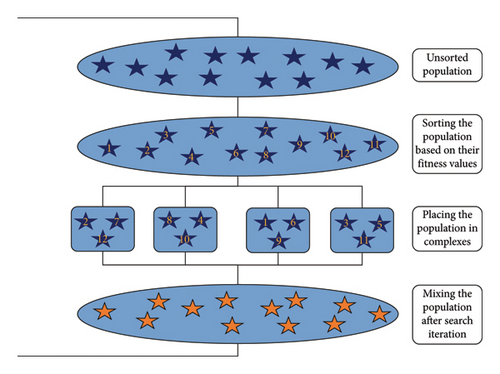
2.2. Resource Allocation
After dividing the population into groups, the main question remains: How should scarce resources be divided? The group expected to perform better than others should have a higher chance of getting more resources. The mean objective function values (MOFV) of members in each group could indicate their capabilities in the upcoming search. Thus, the group with a lower MOFV is expected to perform better.
2.2.1. Rank-Based Fitness Assignment
2.2.2. Roulette Wheel Selection
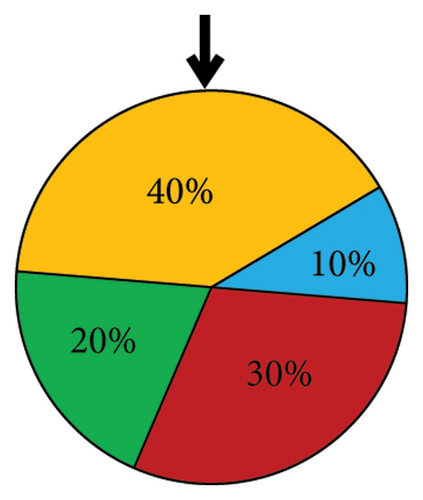
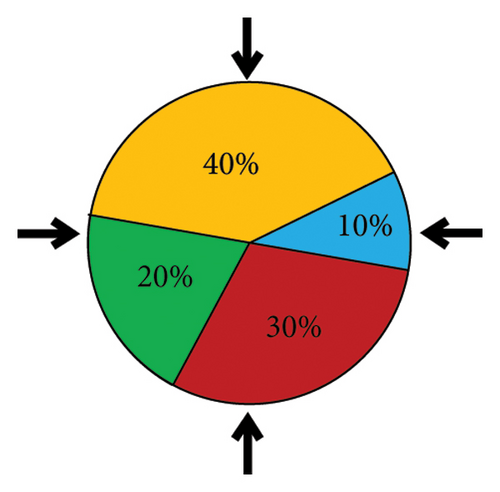
When one of the groups is significantly better than the others, it will occupy most of the wheel. Therefore, when selection occurs multiple times, the least probable choices may be ignored entirely. The stochastic universal sampling (SUS) method was introduced to solve this issue [39]. Multiple equally spaced pointers are implemented in this method instead of one pointer, and the turning occurs once (see Figure 2(b)). Therefore, the issue of selection bias is not present anymore. This study utilized the SUS method for its better overall performance.
2.3. Search Strategy
The Famine Algorithm is a multipopulation scheme, and a search algorithm is still needed to complete the optimization process. Like many other multipopulation techniques, the Famine Algorithm is easily compatible with any population-based metaheuristics, and there is a wide variety of selections for choosing. The Teaching-Learning-Based Optimization (TLBO) algorithm [41] was chosen for this study. Having a satisfactory performance coupled with being straightforward to code and implement and having a minimum need for search parameter adjustments were some of the reasons for choosing this search algorithm.
2.3.1. Teaching-Learning-Based Optimization Algorithm
2.4. Steps of the Famine Algorithm
By implementing the mechanisms defined above, the steps of the Famine Algorithm can be described as follows. First, an initial population with Nind agents is randomly created in the feasible search space and their objective function values are calculated, so they can be sorted considering their fitness. The sorted population is then divided into NG groups using the RSCG process so that every group has equally good, moderate, and weak members of the population. For each group, the MOFV is calculated. Using the fitness function, MOFVs are turned into fitness values, so resource allocation can occur. By utilizing the SUS method, the search turns are divided between groups so that the best-performing group has a higher chance of searching. It is worth mentioning that in each turn, NG resources are available, and by performing probabilistic sortation, multiple groups may not get the chance to search, and conversely, some groups with better previous performance will search multiple times. After getting the resources, the groups will start to search by employing the functions of the TLBO algorithm accordingly. Furthermore, the newfound positions will get updated, and all members will gather together to get sorted and grouped again. This process will continue until the ending criteria are met. The described process can be seen in Figure 3.
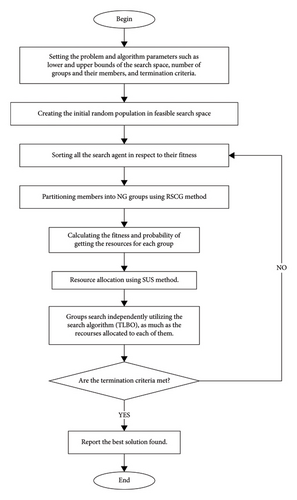
By distributing the resources as stated above, two main benefits are gained. First of all, if the population is on the verge of converging to the global optima or there are no local optima traps nearby, there is no need for all of the population to search the space, and the best-performing group can use more resources to advance the population further much more quickly. Secondly, if there are local minima traps nearby, and the leading groups get trapped, the members of groups that did not have the chance to get the resources to search will remain outside of the trap. Hence, in the next turn, when the population is mixed together and regrouped, a few members in each group remain outside and have a chance of getting the rest of the group out of the trap. As a result, resource usage has been optimized, and the risk of early convergence has been reduced.
3. Damage Detection Methodology
This section presents the needed formulations for modeling the inverse damage detection problem, including damage formulation, noise effect modeling, and objective function definition.
3.1. Damage Formulation
The damage ratio can vary in the range of [0, 1], where 0 denotes a healthy element and 1 indicates total loss of stiffness.
3.2. Noise Effect
3.3. Objective Function
3.3.1. Modal Kinetic Energy
3.3.2. Pseudo-Kinetic Energy
By considering one mode shape to calculate the flexibility matrix and placing unit force on each degree of freedom, ndof static displacement vectors can be calculated. As a result, instead of one kinetic energy value for each member, there are ndof × ndof pseudo-kinetic energy values available. Therefore, there is ndof2 times more detailed data available to compare and locate the damaged elements. The locality of this method will be beneficial in the case of minor damages that are not discernible in changes of more global features.
3.3.3. Proposed Objective Function
3.3.4. Error Calculation
3.4. Illustrated Comparison of the Objective Functions
To illustrate the changes that happened to search space when using the introduced novel feature PKE and objective function (F), a two-bar truss structure is defined and modeled, as seen in Figure 4. The simple truss is comprised of two members with a modulus of elasticity and a material density of 200 GPa and 7780 kg/m3, respectively. The cross-sectional area of members is 0.001 m2. The two variable damage inverse problem is modeled with 20% and 35% reductions of stiffness in members 1 and 2, respectively. The two-dimensional search space of the objective function for conventional MKE change ratio (E) and the novel introduced objective function (F) is shown in Figure 5. To better show the details of the search spaces, the vertical axes are depicted in logarithmic scale. Moreover, to solve the plotting problem of the minus infinity value of log (f = 0) in the global minimum, a small constant (ε) equal to 1.0–6 is added to all the objective function values (log (f + ε)).
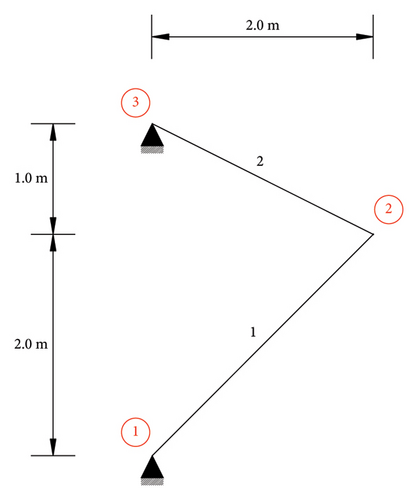
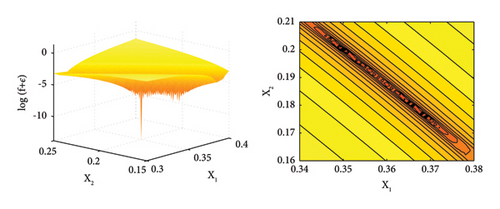

As seen in Figure 5(a), in the search space relating to the conventional MKE change ratio, there are multiple local minima that can hinder the search process by trapping the search agents. In contrast, after exploiting the static displacement to calculate PKE and objective function (F), it seems the search space shown in Figure 5(b) has been cleared of local minima, leaving only the global minimum. This change will simplify the search space and increase the overall convergence speed by removing the local minima traps.
4. Method Efficiency Evaluation
4.1. Performance Monitoring and Convergence Behavior
To better understand the difference that the Famine Algorithm makes on the base optimization algorithm’s performance, the positions of the search agents and their behavior are studied in this section. Mathematical benchmark problems are one of the primal methods of studying the performance of optimization problems. Therefore, one unimodal and one multimodal mathematical benchmark problem, along with the 2-bar truss damage detection problem in Sections 3 and 4, are selected and investigated in 2D space. Furthermore, details and the formulation for these mathematical benchmark problems can be seen in Table 1 and Figure 6.
| Function | Range | fmin |
|---|---|---|
| [−100, 100] | 0 | |
|
|
[−50, 50] | 0 |
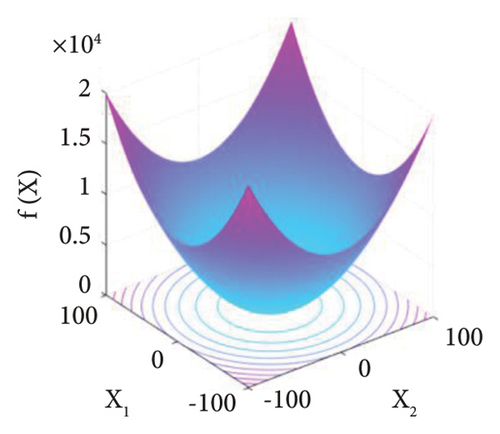
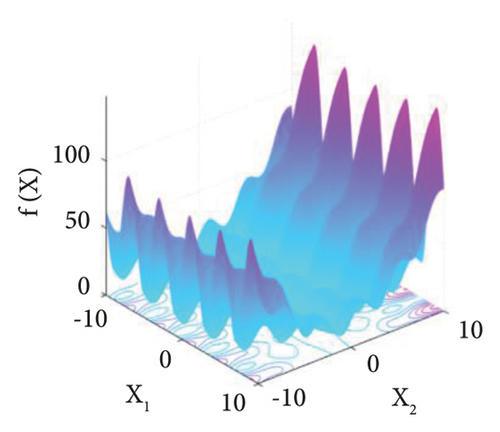
In Figures 7–9, the search process of both Famine and base TLBO algorithms are depicted for the f1, f2, and 2-bar truss damage detection problems, respectively. The dots in the search space represent the ten best search agents of algorithms in noted iterations. Moreover, the positions in the initial population, first iteration, 10th iteration, and 20th iteration are included to show the progress thoroughly. Incepting the results in Figures 7–9, it is apparent that the convergence speed of the Famine Algorithm exceeds the base TLBO algorithm. In all three cases, in the 10th and 20th iterations, the Famine Algorithm seems to have converged to the global minimum, whereas the TLBO algorithm’s members are still dispersed, and in the case of the f2 function, which has multiple local minima traps, some of its members seem to have gotten trapped.






4.2. Numerical Examples
In this section, numerical examples of damage detection problems have been investigated. Four structures are modeled, including two- and three-dimensional trusses and a planner frame. Apart from ideal noise-free conditions, noise pollution effects are also studied in all of the examples. Since the mode shapes are generally measured less accurately than natural frequencies, the natural frequency and mode shape data are perturbed by 1% and 3% noises, respectively [18, 45–47]. Furthermore, for taking the incomplete data effects into account, only the first five natural frequencies and their corresponding mode shapes are used in all numerical examples. To have an unbiased and statically valid comparison, all of the reported results are average values of 30 independent runs for each case.
4.2.1. 25-Bar Planar Truss
The first numerical example is the 25-bar planner truss, which can be seen in Figure 10. Properties of the elements constructing this model are modulus of elasticity (E) of 200 GPa and material density (ρ) equal to 7780 kg/m3, and all members have 10 cm2 of cross-sectional area (A). This structure has 12 nodes and three constraints resulting in 21 degrees of freedom. Three different damage scenarios, including single, double, and multiple damaged elements, are considered, which can be seen in Table 2, and the only first five mode shapes and natural frequencies are used. To demonstrate the difference in performance between the conventional MKE and the newly introduced PKE features, objective functions F and E are both used to determine damage location and severity. Moreover, three well-known features, including modified total modal assurance criterion (MTMAC) [10, 48], modal strain energy-based index (MSEBI) [49], and multiple damage location assurance criterion (MDLAC) [50], are tested for better comparison of the error index and performance of the suggested method. The details of these additional features and their respective objective functions can be found in Table 3. Apart from the objective functions, all other search conditions are similar. The Famine Algorithm is used to find the minima, and five groups of four search agents are allocated for the task. The maximum NFE is set to 10000.
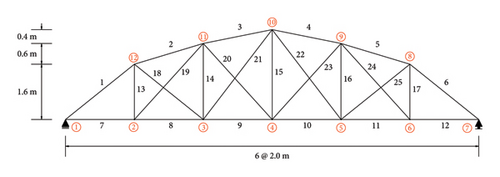
| Scenario | I | II | III | ||||
|---|---|---|---|---|---|---|---|
| Element number | 1 | 5 | 15 | 23 | 2 | 21 | 15 |
| Damage ratio (%) | 20 | 35 | 15 | 25 | 25 | 10 | 15 |
| Feature | Objective function |
|---|---|
|
|
|
|
|
|
|
FMDLAC = −MDLAC |
Figure 11 shows the average results obtained from the PKE and MKE functions in noisy and noise-free states. As evident in Figure 11, the Famine Algorithm successfully found the minima of both objective functions and location, and the severity of damages is discernible, though minor errors can be spotted. To further show the differences in damage detection of objective functions, the error indexes are depicted with box plots for all scenarios in Figure 12. As can be seen in all scenarios, the novel PKE feature and objective function (F) have performed better, considering all objective functions were given the same number of NFEs. The mean values of EI are smaller for the PKE in all cases, and the noise-free damage scenario III has the most significant difference of 3.55 × 109 times smaller EI in PKE than in base MKE. The error present in noisy conditions is considerably more prominent than in noise-free runs that are rooted in noise contamination. However, the PKE has been more successful in ignoring these effects than other objective functions. Moreover, the negative effects of incomplete modal data are more prominent in some features. It can be interpreted that expanding each mode shape into statistical displacement in each member and degree of freedom has helped PKE to significantly ignore these errors. However, using some features together has proven to help their accuracy, but PKE on its own by simplifying the search space has shown better convergence. Particularly, in noisy conditions when convergence becomes challenging, certain features encountered difficulties in converging within the limited NFE available. This challenge is reflected by the observed EI values.
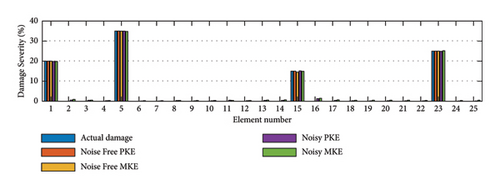
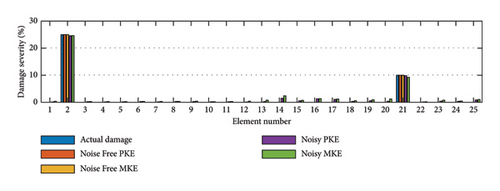
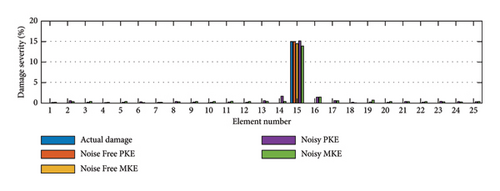
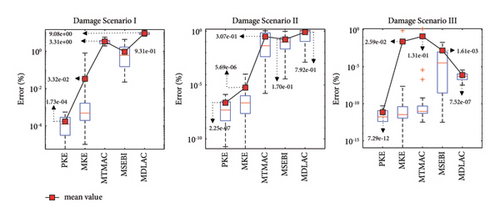
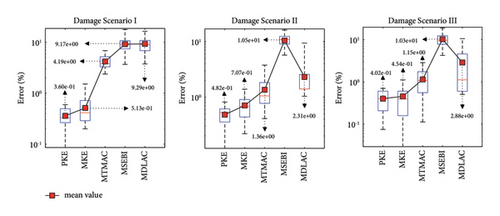
To better see the search progression that resulted in these outcomes, the convergence histories of damage values for damaged elements are shown in Figure 13. Considering the much fewer local minima traps in the objective function (F), it is not surprising that in most cases, damage values converged faster for PKE rather than MKE. In damage scenario III, the superior performance of the PKE feature is more evident as more accurate and faster convergence can be seen.
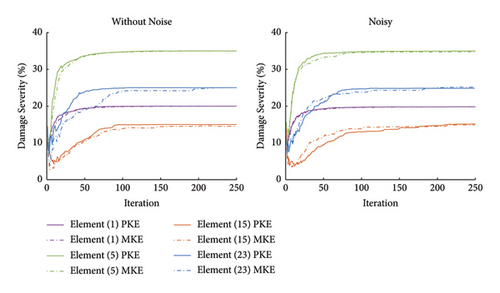
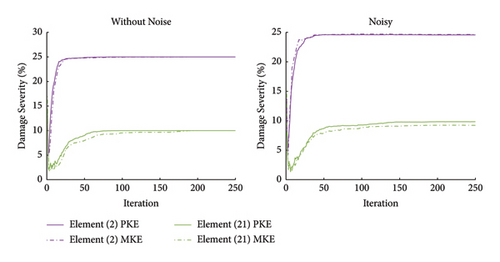
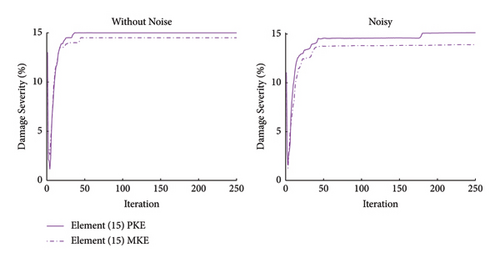
4.2.2. 25-Bar Spatial Truss
The second structure selected in this study is the three-dimensional 25-bar truss structure, as shown in Figure 14. Elements of this truss have a modulus of elasticity of 104 ksi and material density of 0.1 lbm/in3, and cross-sectional area of 10 in2. This example has ten nodes, and six of them are free. Each free node has three degrees of freedom, resulting in 18 degrees of freedom for the whole structure. Again, only the first five mode shapes are considered in this example. The damage cases employed are shown in Table 4. Both single and multiple damage scenarios are considered.
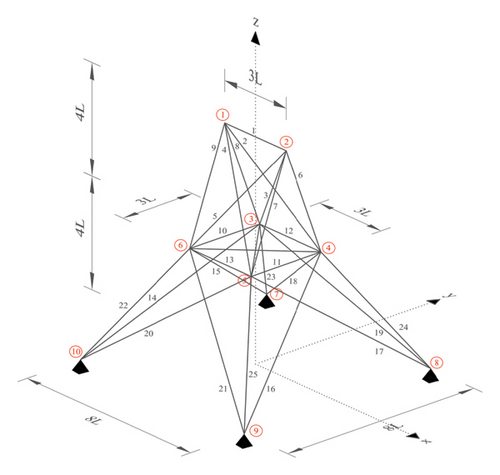
| Scenario | I | II | ||
|---|---|---|---|---|
| Element number | 5 | 13 | 22 | 13 |
| Damage ratio (%) | 20 | 25 | 20 | 20 |
In this example, the efficiency of the proposed novel optimization scheme is compared against multiple well-known optimization algorithms, including TLBO, Gray Wolf Optimization (GWO), and PSO algorithms.
25 search agents that are divided into five groups for Famine Algorithm are assigned to the optimization algorithms, and 30000 NFEs are given to them to search the feasible area of the inverse problem. The GWO algorithm is coded according to [51], and for PSO algorithm, the embedded MATLAB toolbox is used. A summary of the used parameters of these algorithms is listed in Table 5. The damage detection results for mentioned algorithms are presented in Figure 15. The Famine Algorithm and TLBO seem to have performed better than their competitors. To better understand the results, the EI values are presented in Table 6. The EI values seem to validate the previous claim. In all the scenarios, the Famine Algorithm has the smallest EI values compared to the other three, especially in noise-free conditions.
| Algorithm name | Famine | TLBO | GWO | PSO |
|---|---|---|---|---|
| Number of iterations | 600 | 600 | 1200 | 1200 |
| Population size | 25 | 25 | 25 | 25 |



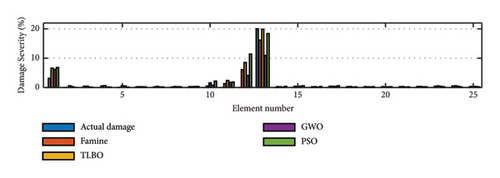
| Scenario | I | II | |||
|---|---|---|---|---|---|
| Noise condition | Optimization algorithm | EI | EI | ||
| Ave | Std | Ave | Std | ||
| Noise-free | Famine | 5.28E − 05 | 9.47E − 05 | 2.50E − 08 | 7.35E − 08 |
| TLBO | 6.22E − 03 | 1.04E − 02 | 2.85E − 02 | 1.56E − 01 | |
| GWO | 1.54E + 00 | 9.53E − 01 | 1.98E − 01 | 3.42E − 01 | |
| PSO | 1.39E + 00 | 2.90E + 00 | 1.51E − 01 | 3.58E − 01 | |
| Noisy | Famine | 1.03E + 00 | 4.82E − 01 | 1.13E + 00 | 6.68E − 01 |
| TLBO | 1.59E + 00 | 9.51E − 01 | 1.60E + 00 | 1.00E + 00 | |
| GWO | 2.34E + 00 | 9.64E − 01 | 1.21E + 00 | 6.73E − 01 | |
| PSO | 2.06E + 00 | 2.21E + 00 | 1.56E + 00 | 1.06E + 00 | |
The reason for the Famine Algorithm’s superiority can be realized by investigating the convergence histories. Figure 16 shows that in all the attempts, the Famine Algorithm has the quickest convergence, and in three of four conditions, it was able to find smaller minima than its counterparts due to its better use of the NFEs and the avoidance of local minima. TLBO, GWO, and PSO algorithms are placed above the Famine Algorithms, respectively, and some premature convergences have occurred because of the local minima traps. The best performance of Famine Algorithm can be seen in noise-free conditions of scenario II because there is no noise error to hinder the search and force convergence. As a result, the Famine Algorithm was able to find the damage 1.14 × 106, 7.92 × 106, and 6.04 × 106 times more accurately than TLBO, GWO, and PSO algorithms, respectively.
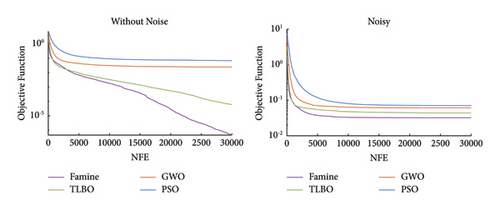
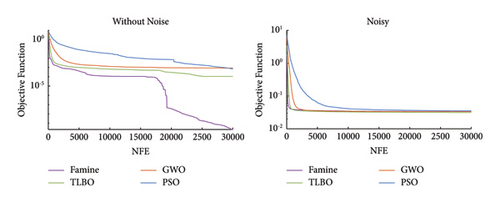
4.2.3. 23-Element Asymmetrical Planar Frame
The third employed example is an asymmetrical planner frame with 23 elements [18]. The details of the constructed model can be seen in Figure 17. The figure shows that the frame is constructed of 14 columns and nine beams connected in 14 free nodes of 18 total nodes. Each free node having three degrees of freedom will result in the 42 total degrees of freedom for the structure. The material density and modulus of elasticity for all the elements are ρ = 7850 kg/m3 and E = 200 GPa, respectively. However, the cross-sectional area, moment of inertia, and mass per unit length for beam and column elements differ. For column elements, Acolumn = 1.6 × 10−2 m2, Icolumn = 3.5 × 10−4 m4, and = 125.6 kg/m, respectively. Moreover, for beam elements, Abeam = 1.62 × 10−2 m2, Ibeam = 3.85 × 10−4 m4, and = 1300 kg/m, respectively. Both multiple and single damage cases are considered, and the details are given in Table 7. It is worth mentioning that like before in this example, only the first five mode shapes are used.
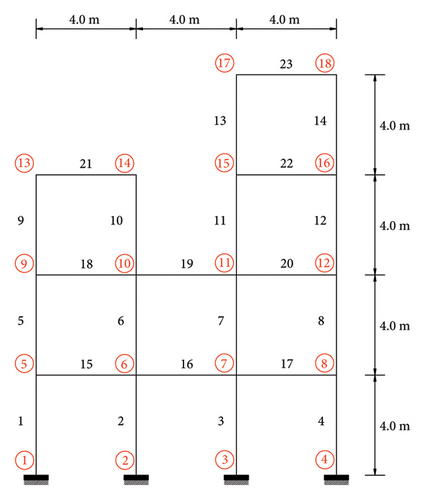
| Scenario | I | II | ||
|---|---|---|---|---|
| Element number | 4 | 18 | 21 | 10 |
| Damage ratio (%) | 15 | 35 | 20 | 25 |
The Famine Algorithm and base TLBO algorithm were utilized to minimize the objective function (F) to study the performance of the damage detection process suggested by this study in frame structures. The search conditions for both algorithms are considered the same, so the maximum number of NFE is set to 40000 to ensure convergence, and the total search agent’s numbers are set to 32 that are grouped in three eight-membered groups for the Famine Algorithm.
Figure 18 shows the damage detection results for both algorithms in noisy and noise-free conditions. To further clarify the differences in the performance of these two algorithms, the convergence histories are plotted in Figure 19. In all cases, it is evident that the Famine Algorithm has a quicker convergence rate than the basic TLBO algorithm. Therefore, given a specific objective function value, the Famine Algorithm will be able to reach that value using fewer NFEs than the TLBO algorithm.
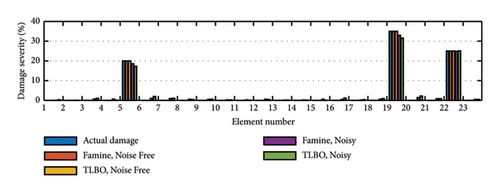
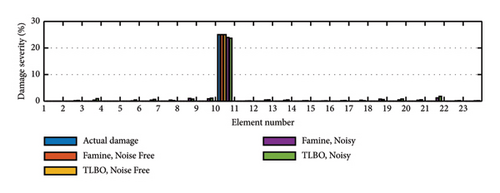
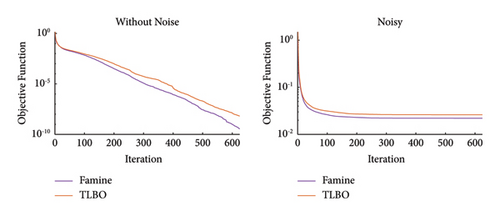
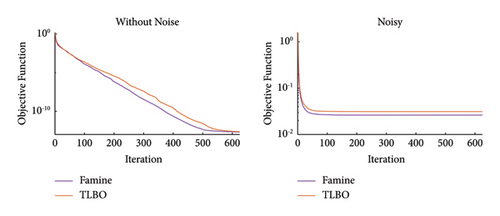
As for the performance of the objective function, the statistical results for EI values are presented in Table 8 that show ignorable error percentages attesting to its efficient accuracy. In addition, the EI values in cases that use the Famine Algorithm are lower, resulting from quicker convergence and smaller objective function values found. The most considerable difference can be seen in the noise-free damage scenario (I), with 32.9 times more accurate results in the Famine Algorithm.
| Scenario | I | II | |||
|---|---|---|---|---|---|
| Noise condition | Optimization algorithm | EI | EI | ||
| Ave | Std | Ave | Std | ||
| Noise-free | Famine | 1.72E − 08 | 2.91E − 08 | 8.31E − 12 | 3.42E − 12 |
| TLBO | 5.66E − 07 | 1.79E − 06 | 9.70E − 12 | 5.92E − 12 | |
| Noisy | Famine | 7.01E − 01 | 2.12E − 01 | 3.85E − 01 | 2.21E − 01 |
| TLBO | 9.05E − 01 | 5.07E − 01 | 5.01E − 01 | 2.92E − 01 | |
4.2.4. 72-Bar Spatial Truss
The final numerical example is dedicated to evaluate the efficiency of the proposed methods in structures with a higher number of dimensions. This truss [18, 45] is constructed of 72 elements as it can be seen in Figure 20. The 16 free nodes will result in 48 degrees of freedom in three-dimensional space. All the elements have a modulus of elasticity of 69.8 Gpa, material density of 2770 kg/m3, and cross-sectional area of 25 cm2. Four nonstructural weights have been placed on the four highest nodes of the structure. In Figure 20, m is equal to 2270 kg and L is 1.524 m.
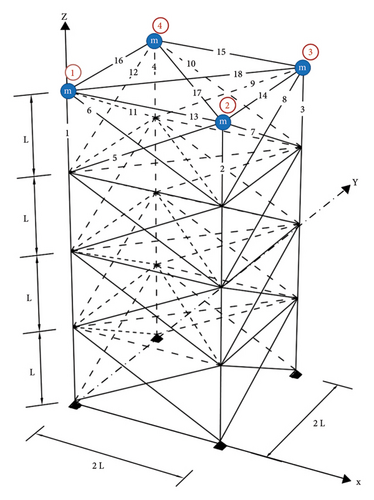
The symmetric nature of this structure adds to the complexity of the damage detection process. Two damage scenarios are considered according to Table 9. Like other examples, only first five modal values are used and noise effects are considered.
| Scenario | I | II | ||
|---|---|---|---|---|
| Element number | 1 | 21 | 37 | 8 |
| Damage ratio (%) | 25 | 20 | 30 | 25 |
Famine Algorithm and TLBO algorithm are used for the minimization task. For better comparison, the maximum number of function evaluations is set to 30000 and six three-membered groups of search parties or 18 search agents are allocated to the task.
The overall performance of the suggested method can be seen in Figure 21, and the location and severity of the damage elements have been accurately detected by the Famine Algorithm. However, there are minor inaccuracies in the results of the Famine Algorithm but more major errors can be seen in TLBO results. This can be further seen in EI results presented in Table 10. The EI results show the maximum of 10.13 times more accuracy in noise-free conditions in case one for the Famine Algorithm. As expected, noise presentation added to the inaccuracy of the process. The reason for these results can further be interpreted from Figure 22 that shows the quicker convergence for Famine Algorithm, thus giving more accurate detection.

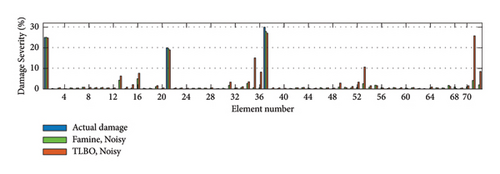
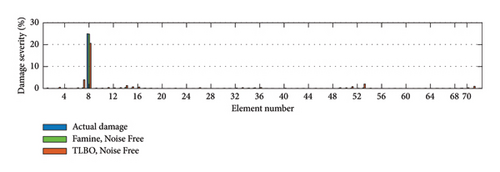
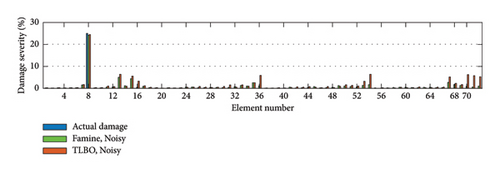
| Scenario | I | II | |||
|---|---|---|---|---|---|
| Noise condition | Optimization algorithm | EI | EI | ||
| Ave | Std | Ave | Std | ||
| Noise-free | Famine | 3.20E − 02 | 2.62E − 02 | 4.07E − 02 | 6.48E − 02 |
| TLBO | 3.24E − 01 | 3.87E − 01 | 3.04E − 01 | 5.11E − 01 | |
| Noisy | Famine | 7.73E − 01 | 4.73E − 01 | 7.16E − 01 | 4.09E − 01 |
| TLBO | 1.86E + 0 | 1.23E + 0 | 1.31E + 0 | 8.95E − 01 | |
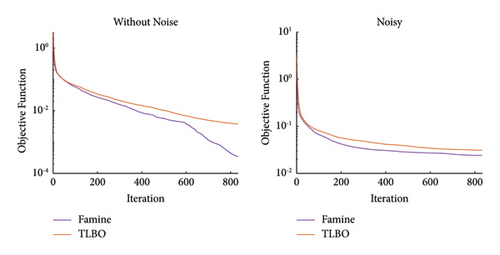
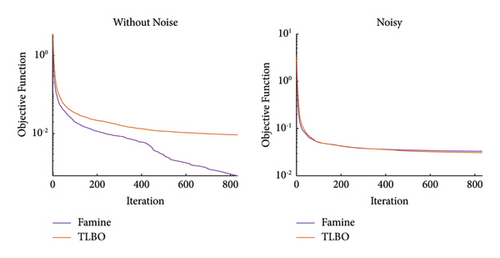
4.3. Experimental Validation
An experimental example [52, 53] is considered in this section, to test the performance of the suggested method in real-life problems. Unlike the damage detection procedure in numerical examples, the experimental examples need two steps to locate the damage correctly. In the first step, the healthy FEM model is updated using the healthy experimental modal data so that the FEM model can be a good representative of the actual structure. In the second phase, the updated healthy FEM model is compared to the modal data from the damaged structure to locate the damage.
4.3.1. Three-Story Shear Frame
The shear frame structure illustrated in Figure 23 stands 2.1 m tall and has three stories. The floors are made from 650 × 650 × 30 mm stainless steel plates, and the columns are 30 × 30 mm equal angles made from aluminum. Furthermore, columns with 4.5 or 3.0 mm thicknesses are used to model the undamaged and damaged elements, respectively, and the columns are bolted to the floors and by aluminum brackets. The model is mounted on a shake table, and the data are collected by one uniaxial accelerometer on each floor and shake table in the direction of ground motion. The damage scenario is introduced by using the thin columns in the first story, which will result in a seven percent stiffness loss in the collective stiffness of the first story. Modal data are extracted for both healthy and damaged states using the data collected from the sensors and can be seen in Figure 24 and Table 11. A numerical lumped mass shear frame model with three degrees of freedom in the excitation direction is created for this structure. The Famine Algorithm and the base TLBO algorithm were utilized throughout the model updating and damage detection phases. The maximum number of NFEs allocated is 2000, and 12 search agents, or four groups of three search agents in case of Famine Algorithm, are assigned to:
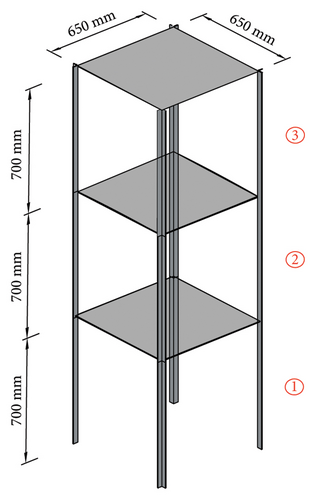
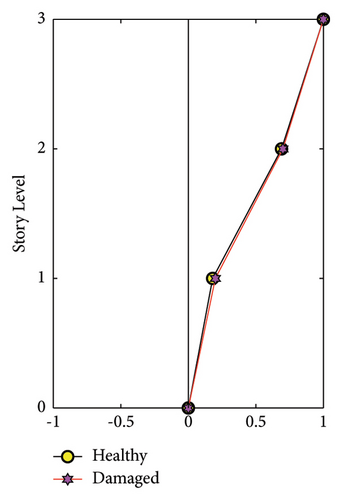
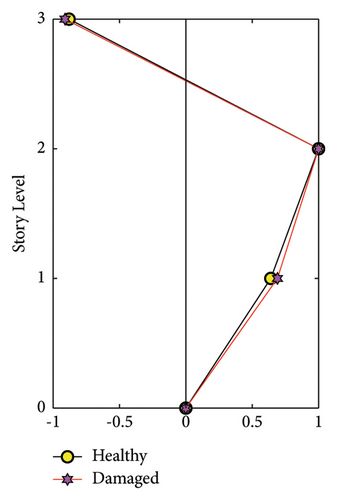
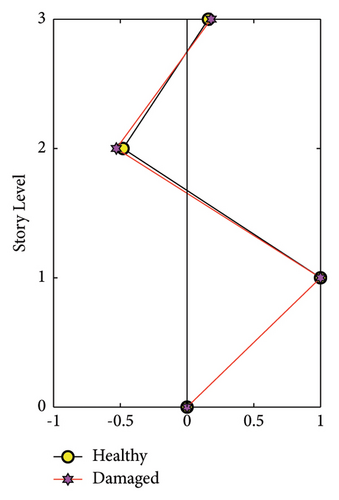
| Mode | Healthy (Hz) | Damaged (Hz) |
|---|---|---|
| 1st | 1.93 | 1.879 |
| 2nd | 5.52 | 5.43 |
| 3rd | 8.55 | 8.30 |
(1) Initial Model Updating Phase. Because there are no exact stiffness measurements in the healthy state of this structure, an initial rough estimation is needed to start the model updating process. For the second and third stories, stiffness values are estimated to be about 9,300 N/m, whereas for the first floor, because of the additional brackets that were used to abate any unwanted torsional movements, the stiffness is considered to be equal to 40,000 N/m.
Using the roughly calculated stiffnesses, the finite element model is created and is ready for the initial model updating phase using the healthy state data. The results of updated stiffnesses for both algorithms can be found in Table 12. The modal assurance criteria (MAC) and frequency change ratio (ΔFr) values are calculated for experimental and obtained mode shapes to evaluate the accuracy of these results and are presented in Table 13. Better agreement between experimental and obtained mode shapes and natural frequencies can be seen in the results of the Famine Algorithm compared to the TLBO algorithm.
| Story | Stiffness (N/m) | |
|---|---|---|
| Famine | TLBO | |
| 1st | 24133.86 | 24955.73 |
| 2nd | 9543.52 | 9430.65 |
| 3rd | 8135.45 | 8178.07 |
| Mode | MAC | ΔFr (%) | ||
|---|---|---|---|---|
| Famine | TLBO | Famine | TLBO | |
| 1st | 0.9993 | 0.9996 | 10.48 | 10.67 |
| 2nd | 1.0000 | 0.9997 | 0.00 | 0.57 |
| 3rd | 0.9991 | 0.9996 | 7.42 | 6.87 |
(2) Damage Detection Phase. By having the updated healthy model, damage detection can be carried out. The result of the damage detection process is presented in Figure 25. The Famine Algorithm seems to have more accurately detected the damage than the TLBO algorithm. Minor errors are seen in the third story due to noise effects and fem model simplifications. To better compare the performance of the two algorithms, convergence curves are plotted for both phases. Figure 26 shows that the Famine Algorithm converged more quickly, especially in the first phase, and found smaller minima than the base TLBO algorithm.

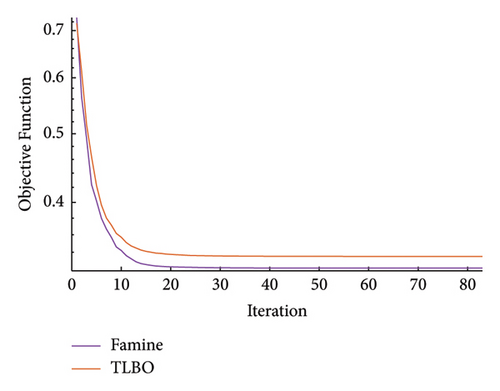
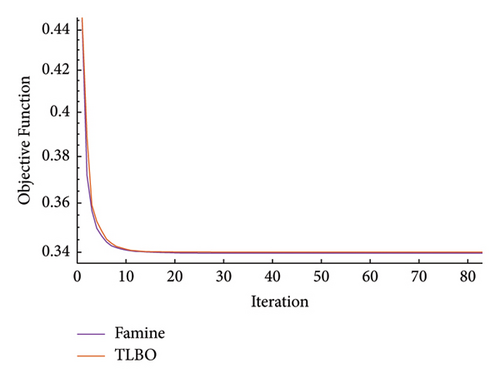
5. Conclusion
This study presented a new optimization-based model updating method for structural damage detection. Firstly, a multipopulation scheme named Famine Algorithm is introduced, which tries to lower the number of cost function evaluations needed for optimization algorithms to converge. This claim is tested and confirmed in 2D space for multiple examples. Secondly, a novel damage-sensitive feature named pseudo-kinetic energy is developed and is used in the objective function for the damage-detecting process. Three numerical examples and one experimental example are provided to illustrate the method’s capabilities. Firstly, a comparison between PKE and conventional KE features is presented for the 25-bar planar truss. The results for this truss show that the new feature can detect damage much more accurately than the conventional KE. Moreover, as illustrated in 2D space for the example of 2-bar truss, the PKE has a much simpler search space than KE. At its best performance, compared to MKE, PKE’s error values were 3.55 × 109 times smaller.
In the second example, damage detection is carried out for 25-bar spatial truss using multiple well-known optimization algorithms to compare against the Famine Algorithm. The convergence histories show that in all scenarios, the Famine Algorithm was the quickest to converge and was able to reach smaller objective function values than its competitors placing TLBO, GWO, and PSO algorithms in lower ranks, respectively. To further clarify, by just adding the Famine Algorithm to the base TLBO algorithm, the error values were 1.14 × 106 times smaller in its best-case scenario.
The last numerical example is allocated to evaluate the performance of the proposed method in frame structures. Performance improvements are noticeable when the Famine Algorithm is added to the base optimization algorithm and the location and severity of damages are found with acceptable precision. Again, the result for the Famine Algorithm was 32.9 times more accurate than the base TLBO algorithm in its best. In all numerical examples, the noise effects were investigated and only the first five mode shapes were used to include the incomplete data effects.
In the last example, an experimental three-story shear frame is considered to test the performance of the suggested method in real-life problems in which the suggested framework was able to detect damage with minor errors. The process included two phases, the initial model updating phase and damage detection. The final results show that adding the Famine Algorithm leads to more accurate damage detection.
Conflicts of Interest
The authors declare that they have no conflicts of interest.
Authors’ Contributions
S.M., A.K.G-T., and H.R. contributed to this study. S.M. carried out conceptualization, data collection and analyses, interpretation of the results, and preparing the first draft of the manuscript. A.K.G-T. and H.R. contributed to the conceptualization, design and conducting of the study, and critical revision of the manuscript.
Open Research
Data Availability
The data that support the findings of this study as well as the optimization framework referred herein are available from the corresponding author upon reasonable request.




